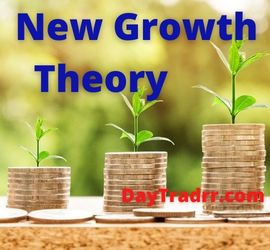What Is New Growth Theory?
 The New Growth Theory is an economic concept. It holds that humans’ unlimited desires foster ever-increasing productivity and economic growth. It contends that because of people’s insatiable desire for profit, real GDP per person will continue to rise indefinitely. The New Growth Theory, sometimes known as the NGT, is a modern view of the forces that drive economic success and growth.
The New Growth Theory is an economic concept. It holds that humans’ unlimited desires foster ever-increasing productivity and economic growth. It contends that because of people’s insatiable desire for profit, real GDP per person will continue to rise indefinitely. The New Growth Theory, sometimes known as the NGT, is a modern view of the forces that drive economic success and growth.
According to the NGT, economic productivity and growth are intimately related to human factors. Particularly, what humans desire and need. The primary underlying logic is that people’s desires are nearly limitless or infinite. As a result, these needs drive their buying and investment choices. In turn, these purchases and investments drive the economy. According to the theory, the actual GDP per person grows indefinitely as a result of people’s desire to make money. When earnings in a particular area fall, people will continue to look for better ways to solve the problem in order to maximize profits.
New Growth Theory – A Closer Look
The new growth theory provides a new perspective on what drives economic success. It highlights the role of entrepreneurship, knowledge, innovation, and technology. This is in direct opposition to the neoclassical economics perspective of exogenous development. The neoclassical view holds that economic advancement is governed by uncontrollable external causes. A central tenet of NGT is that profit is squeezed by competition. Therefore, individuals must always explore better methods to accomplish things. There is a constant motivation to innovate new products to increase profitability.
According to the hypothesis, innovation and new technologies do not emerge by coincidence. Rather, they are determined by people who are looking for new innovations or technologies and how hard they are seeking them. People also have control over their knowledge capital—what they study, how hard they study, and so on. If the economic incentive is strong enough, individuals will opt to invest in human capital and search harder for new breakthroughs. One important feature of the new growth theory is the concept that knowledge is viewed as a growth asset. Knowledge is not subject to limited constraints or decreasing returns like other assets such as money or real estate. Rather, knowledge is an intangible rather than a physical attribute that may be developed inside an organization or business.
New Growth Drivers
The New Growth Theory challenges conventional wisdom. A successful, rising economy is not molded almost entirely by external factors that cannot be predicted or controlled. Rather, personal, individual forces are ultimately the drivers of economic progress. The NGT emphasizes:
- Technology is a tool for people to gain creative and effective access to the market and earn wealth. Individual activities on a person’s own behalf then have a collective influence on the economy.
- Knowledge is a commodity that enhances an individual’s capacity to gather further information. Unrestricted, a person is free to gather the information required to make educated, intelligent judgments. In turn, these decisions will ultimately impact the overall economy.
- Entrepreneurship is simply a concept that underscores the necessity of people taking on responsibility. It describes the active pursuit of physical, personal, and financial objectives and requirements. The next logical step is to invest in methods that allow them to fulfill their goals and requirements. Coincidently, they also generate profits or income that they can live off of and continue to build upon for the rest of their lives.
Who Proposed the New Growth Theory?
NGT According to Romer
- The pace of change – How people and organizations react to economic incentives influences the pace of technological progress.
- Diminishing returns at the firm level – At the company level, firms will raise their production at a diminishing pace as they add to their stock of knowledge capital.\
- Increasing returns at the macroeconomic level – At the level of the entire economy rather than just individual firms, however, knowledge capital is subject to increasing returns.
Increasing returns are possible because once found, information becomes accessible to everyone. Conversely, the use of physical capital, such as a computer or factory equipment is excludable. This is because the business that owns the capital may prevent other enterprises from utilizing it. Rival goods are products or services that can only be owned or used by one person, generating competition and demand for it.
New Growth Theory Implications
A key feature of the new growth theory is that, unlike capital and land, economists see knowledge as a growth asset with no decreasing returns or constraints. According to them, it is an intangible characteristic and a valuable resource that allows businesses and industries to flourish from within. According to new growth theory, new technologies and breakthroughs do not arise by coincidence. Rather, they are determined by the number of individuals who are actively seeking them. People may also choose how much knowledge capital they wish to acquire. They may, for example, pick what to study and how seriously they wish to pursue it. As a result, if the economic motive is strong enough, individuals will prioritize human capital expansion. Additionally, they will actively seek technologies that will assist them in achieving this goal.
New Growth Theory prioritizes human capital as the most precious resource in any economy. Governments and businesses should strive to achieve maximum economic growth and prosperity. Therefore, they should concentrate their efforts on providing avenues for individuals to maximize their learning. Simultaneously, fostering opportunities for individuals to engage in research, exploration, development, and entrepreneurial endeavors.
The importance of knowledge
Developing new knowledge is the fundamental driver of economic progress. In order to thrive, economies should shift away from relying only on physical resources to build their knowledge base. Instead, they must support institutions that aid in the development and sharing of information. According to new growth theorists, firms usually undervalue the utility of knowledge. As a consequence, it is primarily up to governments to invest in human capital. Governments are urged to make superior education more accessible. Further, to promote and incentivize private-sector research and development (R&D).
Governments should invest in knowledge since individuals and businesses are not always motivated to do so. For example, although gaining knowledge does not deprive anybody else of knowledge (the concept of nonrivalry of knowledge), its utility to people and enterprises may not be fully appreciated. This is despite the fact that knowledge may provide growing returns and drive economic progress. As a result, the government should invest in human capital as well as education and skill development. It should also assist private-sector R&D and stimulate inbound investment, which will bring with it new expertise.
New Growth Theory Example
One of the motivations for firms to invest in human capital is to foster internal innovation. Individuals will be motivated to create new ideas and technologies for the consumer market if opportunities and resources are made accessible inside a business. A major corporation, for example, may enable a portion of its workforce to concentrate on separate, internal initiatives that might lead to new ideas or businesses. In certain respects, the enterprise allows them to behave as if they were startups being nurtured inside the business.
Employees are motivated to launch a new invention by the prospect of increasing revenues for themselves and the company. This is particularly true in the United States, where service-type businesses are increasingly driving trade. Following the new growth hypothesis, software and app development may take place inside businesses. Such knowledge-driven development requires consistent investment in human capital. This may establish an atmosphere in which talented individuals can execute their core responsibilities. But, allow them to explore the development of new services that can benefit and be used by the general population.
(Sources: web.stanford.edu, economicsonline.co.uk, thebusinessprofessor.com, infoque.com, & investopedia.com)
Up Next: What Is Painting the Tape?
 Painting the tape is a kind of market manipulation in which market participants try to affect the price of a security. One method is by purchasing and selling it among themselves in order to create the illusion of significant trading activity. The purpose of painting the tape is to create the perception of increasing interest in a company. Ultimately, the activity will entice new investors to acquire shares, causing the price to rise.
Painting the tape is a kind of market manipulation in which market participants try to affect the price of a security. One method is by purchasing and selling it among themselves in order to create the illusion of significant trading activity. The purpose of painting the tape is to create the perception of increasing interest in a company. Ultimately, the activity will entice new investors to acquire shares, causing the price to rise.
Because it produces false pricing, painting the tape is an unlawful act that is forbidden by the Securities and Exchange Commission (SEC). The SEC controls and monitors financial market activities to guarantee that trading takes place in a fair and orderly way.
The majority of market manipulation activities will be directed toward more obscure and low-volume assets. For example, over-the-counter (OTC) stocks, since they face less regulation and attention Additionally, their lower volume provides a more fertile background for market manipulation strategies. There is a high potential cost of attempting to manipulate the price or volume of a security with a high market capitalization. This is especially true of market manipulation efforts that involve painting the tape.




